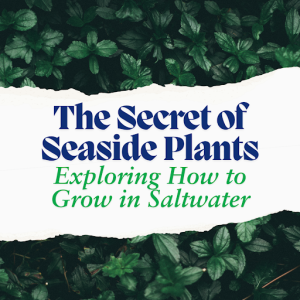The Secret of Seaside Plants: Exploring How to Grow in Saltwater
By Mackenzie Smith, C2ST Intern, Loyola University
The question “How about this crazy weather?” has dominated small talk throughout the ages. While humans and weather have often been at odds throughout history, many recognize that the world’s climate today looks different than it once did. People may notice shorter winters compared to 70 years ago and more intense tropical storms. As the world changes, we need to address the question of how to grow the food that feeds us in more adverse conditions. Knowing this can help us tackle the issue of rising oceans overtaking farmland and harming crop production. Thanks to cutting edge research, scientists interested in this problem have discovered the key reason why certain plants are better at surviving in saltwater.

As anyone with a garden or even a flower box on the windowsill knows, different plants have unique needs and each varies in how resilient, or able to survive changes to their environment, it is. You wouldn’t normally think to fill your watering can with salt water, but plants that live in salt marshes grow well in these conditions. These marshes are sections of land found on coasts that are periodically flooded by ocean water. As a result, only some greenery can thrive there. Researchers recently set out to understand why that is and started by trekking into the salt marshes of Norfolk, UK to gather samples of a plant called cordgrass that grows there.
The researchers discovered that the secret to cordgrass’ success seems to lie in their DNA, as an analysis showed they have high levels of genes that make a substance called dimethylsulfoniopropionate, or DMSP for short. Scientists have known for a while that DMSP is high in ocean algae blooms. Interestingly, in the ocean, DMSP is broken down into DMS, a chemical that can enter the atmosphere and encourage cloud formation. It is thought that this may even provide a cooling effect on the planet. In this recent study, the researchers from Norfolk have pushed the boundaries of what we know this climate-relevant chemical is capable of. Diving deeper showed that DMSP plays a big role in how plants react to stress. For example, it triggers a molecular messenger called auxin. This molecule can send signals within plants to coordinate growth and development, and help them figure out how to respond to stressful conditions.
The next question the researchers asked was whether giving DMSP to a more sensitive plant that doesn’t normally thrive in stressful, salty conditions would make it resilient to salt water. Researchers used tomatoes, which need specific water conditions to grow well, to test this. Tomato plants in salty growing conditions without DMSP had trouble filling out and produced small shoots and roots. Amazingly, adding DMSP yielded healthy, leafy plants that were just as big as those grown in non-stressful conditions. This breakthrough goes to show that learning what makes cordgrass thrive in rough surroundings has wide-reaching implications, even for crops we rely on.
Learning how to grow crops in tougher conditions will be important to adapting to changing climates. This research can help us navigate the threat rising oceans pose to food production, which is more than a hypothetical problem. From Bangladesh to Maryland, we are seeing that encroaching saltwater has made farming more challenging. Further research is needed to see if DMSP can help other types of plants overcome stressful soil conditions, or what effects it would have on large-scale production of foodstuffs. Still, discoveries like this will ensure everyone stays fed as we navigate our changing world.
References
- https://www.washingtonpost.com/weather/2021/09/22/longer-northern-hemisphere-summer-climate/
- https://science.nasa.gov/earth/climate-change/a-force-of-nature-hurricanes-in-a-changing-climate/
- https://sealevel.nasa.gov/faq/17/which-areas-of-the-world-will-be-most-affected-by-sea-level-rise-over-the-next-century-and-after-that/
- https://www.nature.com/articles/s41467-024-51758-z
- https://www.whoi.edu/oceanus/feature/dms–the-climate-gas-youve-never-heard-of/
- https://academic.oup.com/jxb/article-abstract/74/22/7000/7244686?redirectedFrom=fulltext&login=true
- https://cfaes.osu.edu/stories/climate-change-lessons-from-bangladesh%E2%80%99s-disappearing-farms
- https://www.pbs.org/newshour/show/saltwater-from-rising-sea-levels-threatens-future-of-farming-along-chesapeake-bay#:~:text=That’s%20driven%20by%20climate%20change,saltwater%20keeps%20infiltrating%20the%20groundwater.